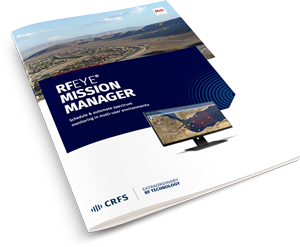
It is the biggest contract in the history of CRFS and caps a string of recent successes which also include significant deals in the Far East and the US worth around £1.5 million. These successes embrace both the military and civilian sectors for our RF spectrum systems.
CEO Alistair Massarella is unable to go into client specifics on the Far East and US successes but said the Cambridge business was really starting to gather mass global traction.
CRFS won a Queen’s Award in April 2013 following significant growth in its export sales of spectrum monitoring and surveillance technology. Over the past three years CRFS has built a strong position in the key US market where it supplies its state-of-the-art RFeye systems to a wide range of customers, including the US DoD, security agencies and commercial companies.
These systems are deployed to help plan and manage efficient spectrum usage and to resolve interference issues, as well as to alert for unauthorised or illegal transmissions that may indicate a security breach, public safety threat – or even espionage.
CRFS has also made significant strides in the last year in building its sales and support channels across South America, Europe, the Middle East and Asia. The company is bidding on some major overseas contracts in these regions which will drive continuing growth of its export sales.
CRFS pioneered the concept of remote real-time networks of spectrum sensors to meet the challenges of modern day spectrum usage.
RFeye system solutions are based on networks of RFeye Nodes configured for specific site requirements, together with the most advanced spectrum monitoring software on the market.
And the technology has just taken a fresh upspin with the launch of a next gen, high-end, wideband receiver family – RFeye Nexus.
The new modules feature class-leading signal interception capability and flexible PCIe interfacing for easy integration into other systems.
Designed for the most demanding signals intelligence (SIGINT) applications, the RFeye Nexus range offers 80 MHz real-time bandwidth from either 100 kHz to 18 GHz or 100 kHz to 6 GHz. Each module is capable of sweeping at 150 GHz/s with excellent noise characteristics for reliable capture of all signals, including short-burst events.
The RFeye Nexus range is modular and has flexible backplane and interface options, allowing modules to be installed in any suitable enclosure and easily connected to power, PCIe, trigger and reference sources.
Modules can be supplied as VITA 3U rack-mountable cards with VPX backplane for integration with the broader sensor arrays typically found in SIGINT or EW systems. They can also be provided as integrator modules with custom fitment and a PCIe connector capable of supporting full IQ data streaming.
Finally, a fully standalone option is available in an IP67 enclosure with PCIe Edge connectivity for users wanting a deployment-ready system. This option also supports a Linux-based control card for on-board data processing and autonomous operation with an optional optical fibre interface for data streaming.
Massarella said: “The RFeye Nexus range is based on our latest superheterodyne receiver design and gives outstanding performance. The extremely low noise and spurious levels allow us to distinguish very low power signals from the noise floor, and thus to find transmissions that might be missed by other SIGINT systems.
“The high sweep speed also makes it possible to capture and analyze all activity across the spectrum up to 18 GHz.”
Multiple RF input ports allow comparison of signals from different antennas, and support direction finding. Timing and synchronisation features allow correlation of data between multiple modules for accurate geolocation of target signals using Time Difference of Arrival or Power on Arrival techniques.
The RFeye Nexus range is supported by the existing RFeye suite of software, and modules can be deployed as part of the end-to-end RFeye Detect or RFeye Secure solutions for wide area and in-building monitoring.
Author - Tony Quested at Business Weekly
About CRFS
CRFS pioneered the concept of remote distributed real-time software-defined networks of intelligent spectrum sensors to provide continuous 24/7 monitoring of the RF environment. The RFeye was developed to help improve the efficiency of modern-day spectrum usage, resolve complex interference issues and provide cyber security for critical buildings and installations.
For more information please visit www.crfs.com
Media Contact:
Kerry Mertz, Sales and Marketing Executive
Tel: +44 (0)1223 815615 Email: media@crfs.com
Watch the webinar
HOW TO RECORD AND EXTRACT SIGNALS FROM BIG RF DATA
Watch the webinar to learn how to improve your RF data recording process and unleash the full potential of your spectrum monitoring system.

GET INSTANT NEWS UPDATES
Subscribe to the CRFS blog to recieve RF news, straight to your inbbox